Abstract
Traditional architecture characteristically uses locally available materials to develop constructive systems and techniques, providing an optimum response to the needs of the population. This study focuses on half-timber walls as a traditional technique taking material form in a wide range of variants found mostly in the northwest half of Spain. Primarily aiming to ensure the broad objective of in-depth documentation, understanding, and study, the microscopic analysis of 24 timber samples obtained from different half-timber walls is proposed. This analysis aims to identify the species or species groups used and to establish a correlation with different aspects of construction including structural resistance, durability, and workability. This makes it possible to identify the predominant use of species found close to the locations from which the samples are obtained, using relatively resistant species for the structural elements of the half-timber wall, as well as the use of species with flexible and easily malleable branches for the construction of the enclosure panels. This indicates that, among the species available in a given location, builders have a degree of knowledge on the characteristics of the material, so they could choose the most suitable ones or develop specific constructive solutions based on these characteristics.
1. Introduction
The value of vernacular architecture partly lies in the fact that it is built for the community itself, based on the experience acquired for the optimal use of the resources available in a location, and adapting to specific conditions and needs [1]. This experience leads to a very wide range of constructive solutions, structural systems, and architectural typologies. Although Spanish traditional architecture is generally linked to constructive techniques such as rammed earth or adobe, there is also an abundance of half-timber walls, mostly in the northwest region of the Iberian Peninsula [2].
This technique is defined by the existence of a timber framework that fulfils most of the structural function, while other types of materials or solutions are used to fill or enclose the spaces between the structure [3]. This framework is always made up of a series of main structural elements, understood as the uprights that go from one floor to another and are interlinked at the ends by the beams. However, another series of intermediate structural elements can appear, connecting the main elements, reducing their buckling length, increasing the bracing or capacity to absorb horizontal force, and forming window and door openings.
The spaces formed by the timber structure can be filled in or enclosed with numerous materials, depending not only on conditioning factors such as the nearby availability of raw materials, but also on specific conditioning factors such as the building’s importance and function or the financial situation of its owners. The different variants documented in Spain have been classified according to the associated constructive logic, grouped into monolithic infills relating to the use of formwork (Figure 1a); masonry infills stacking pieces that were carved beforehand (Figure 1b); lightweight rigid screens made up of laths, boards, or other firm elements (Figure 2a); finally, flexible screens built with malleable plant elements such as branches, wattle, or reeds (Figure 2b).
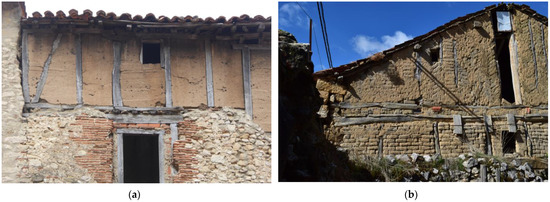
Figure 1.
Examples of half-timber walls with heavy infills: (a) monolithic infill of gypsum concrete in Pancorbo (Burgos); (b) masonry infill of adobe infill in Moral de Hornuez (Segovia).
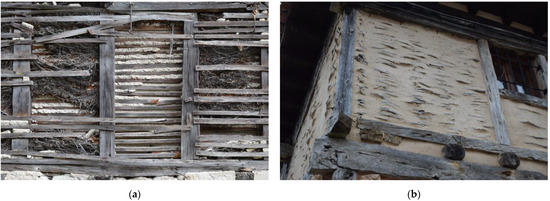
Figure 2.
Examples of half-timber walls with lightweight screens: (a) rigid screens of lath-and-daub in As Ermidas (Ourense); (b) flexible screen of wattle-and-daub in Calatañazor (Soria).
Although, as a constructive technique, its origin can be traced back to the earliest shelters built by humans [4], and it currently shows the development of the craft, tools, and processes characteristic of carpentry [5], these aspects have not received as much attention as other techniques. Spanish historical architecture treatises have devoted less attention to these techniques than to others traditionally considered to be grander, although since the 19th century, some descriptions published have shed light on their construction [6,7,8,9,10]. However, the documented examples of Spanish traditional architecture display an even greater diversity and ingenuity than that described in historical texts [11]. In contrast, although the 20th century saw the appearance of multiple catalogues and texts on traditional architecture [12,13,14,15,16], these were generally descriptions of dwellings, with occasional mentions of technical aspects, and tended not to detail specific constructive and structural aspects. In the 1970s, there was a generalised trend to study traditional constructive techniques for modern documentation, understanding, and application. This was caused by the energy crises of the time, which had prompted the search for more sustainable models. Despite major advances in this regard, especially in relation to earthen constructive techniques [17,18,19,20] or the structural use of timber on roofs [21,22,23], further study on half-timber walls is still necessary, especially in Spain. The present research aims to achieve a degree of detail equivalent to the wide range of studies on other half-timber typologies found in other locations, including the buildings with colombage and pans de bois in France [24,25,26], fachwerk walls in Germany [27,28,29], baraccata houses in Italy [30,31], pombalino walls in Portugal [32,33], and traditional himi constructions in Turkey [34,35].
This publication is part of broader research to carry out a global study of half-timber walls found in Spanish traditional architecture through the cataloguing of the different variants and the analysis of degradation processes and associated transformation dynamics. The aim of this is to enhance this constructive technique, proposing guidelines for its correct conservation and intervention. With a wide range of variants documented through the study of 1218 half-timber walls, part of the intangible value of these techniques lies in their adaptation to place, as well as to the specific needs and resources available [36].
This text sets out to propose a microscopic identification of 24 timber samples from different walls distributed homogeneously throughout Spain, where this type of constructive technique is found (Figure 3). It should be noted that as this type of technique is generally found on the upper floors of privately owned urban residential buildings [37], the samples obtained were limited to specific cases where access was possible with the owners’ permission.
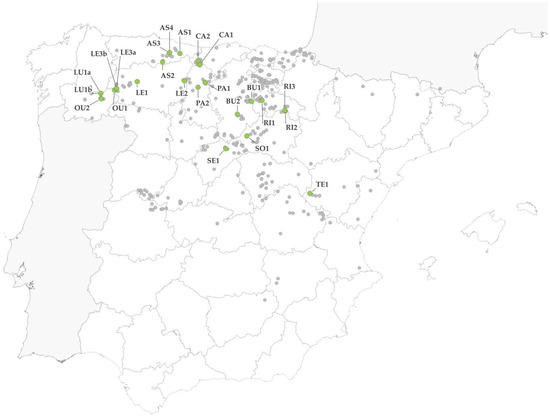
Figure 3.
Distribution map for case studies making up the database. The timber samples analysed in this document appear in green.
Knowledge of the timber species or species groups used in a building is essential for correct historic, constructive, and structural analysis, to be used as the basis for any conservation and restoration project [38]. The use of different timber species within a single constructive element may be due to the existence of two phases in construction or be linked to occasional repairs. In other cases, it may be a reflection of the level of technical knowledge that the builders of the time had about the different types of timber, as well as the conscious selection process of specific types for the production of different constructive elements based on hardness, flexibility, workability, and resistance to degradation.
Moreover, the structural behaviour and durability of timber are conditioned both by external factors such as the degree of exposure to degradation agents or the transformation process observed in the raw material, and by internal factors relating to the material that mostly include the species and defects strictly understood as the result of the genetics of the tree, of growth conditions, and even of the felling and drying processes to which the element has been subjected. The species has a direct effect on the characteristic resistance values, although structural calculations must also consider the quality of the timber, the presence of characteristic defects, and the state of conservation of the material. In addition to influencing strength, the different microscopic characteristics of the species translate into different macroscopic characteristics and behaviours that influence issues relevant to historic architectural structures including durability, workability, and density.
Consequently, the cross-analysis proposed in this text between the species identified and the different aspects of construction mostly aims to ascertain the reasons that may have prompted builders to select given species for the construction of particular elements. Equally, identifying the species used could help understand the frequency with which certain elements from the half-timber walls develop degradation phenomena such as rot or the attack of xylophagous insects [39,40].
2. Materials and Methods
The analysis was carried out on 24 timber samples from different half-timber walls located in Asturias, Burgos, Cantabria, La Rioja, León, Lugo, Ourense, Palencia, Segovia, Soria, and Teruel. The buildings analysed are vernacular and traditional dwellings whose date of construction cannot be determined concretely, but which represent local building techniques characterised by the optimal use of available materials. While it is not possible to completely exclude the importation of timber through river channels, it is very unlikely that the common inhabitants would have chosen to import expensive materials from a great distance if they had other nearby resources and the technical knowledge to build with them.
These samples were purposely obtained from different constructive elements with structural functions including posts and beams, as well as from elements used in the formation of panels for wattle-and-daub and lath-and-daub. Furthermore, as the main objective is the enhancement and conservation of this type of architecture, care was taken to ensure the least possible damage to the built element, taking advantage of areas displaying damage or degradation. To obtain samples, it sufficed to use a chisel and hammer on some open crack to break off a small fragment with minimum dimensions of 5 × 2 × 2 cm. In any case, it was verified that the samples obtained were apparently in a minimum state of preservation that allowed for microscopic analysis, and some samples completely attacked by xylophagous insects had to be discarded and extracted again from healthier areas.
The samples were initially boiled in water to facilitate cutting work and to extract the air contained in the cells. The cut planes were then identified through the use of a magnifying lens, cutting them into small cubic fragments from which to extract the thin slices needed for identification. These thin strips were cut manually using a stainless-steel blade and the samples were secured by freezing them on a Peltier effect plate. They were then placed on a slide in a solution of water and glycerine, without using any sort of specific staining, and were analysed using an optical microscope. Although these slides are of a non-permanent nature, the use of digital cameras in the microscope made it possible to obtain the microphotographs that illustrate this research. The presence or absence of certain relevant microscopic features enabled the identification of samples as belonging to a species or species group through the use of dichotomic identification keys for identification [41]. As certain species share microscopic characteristics, it is not possible to identify the species to which a sample belongs. However, it is possible to identify the species genus to which it belongs as, in addition to sharing anatomical characteristics, they may share similar technological characteristics [38].
3. Results
3.1. Corylus Genus
Samples AS1, AS3, and CA1 were identified as belonging to the Corylus group based on the presence of rings with diffuse porosity, radially grouped pores, rings with slightly undulating growth, greatly diffuse apotracheal parenchyma, aggregated rays made up of heterogeneous biseriate or triseriate rays with a height of 10–15 cells, as well as scalariform perforations with a maximum of 5 to 10 highly distinctive bars (Figure 4) [41].

Figure 4.
Characteristic sections identified as belonging to the Corylus genus: (a) Cross-section of sample AS3; (b) Tangential section of sample CA1; (c) Radial section of sample CA1.
Although, in principle, the species Corylus avellana L., Corylus colurna L., and Corylus maxima Miller cannot be distinguished on a microscopic level, based on geographical distribution, it is most likely to be Corylus avellana L. (Figure 5), as the others have not been documented in Spain [42]. The species Corylus avellana L., commonly known as a hazel, is characterised by its bush-like shape and is up to 8 m high, with flexible branches that have traditionally been used for the execution of woven elements such as baskets, chair backs, fences, and partition walls [43]. Its timber generally displays medium resistance and limited durability [44]. All the samples were from rods used to build the wattle-and-daub enclosure of half-timbered walls in buildings located in Carbes (Asturias), El Moro (Asturias), and Coloca (Cantabria).
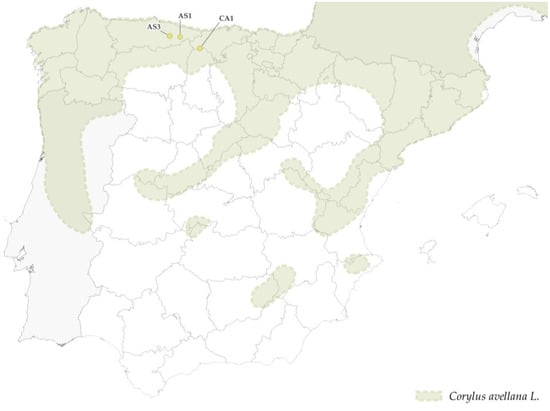
Figure 5.
Distribution map for the species Corylus avellana L. and location of the cases identified as belonging to this species. Map drawn up by the authors using the information obtained from the database Chorological Data for the Main European Woody Species [42].
3.2. Castanea sativa Miller
Samples AS2, AS4, LE3a, LE3b, and LU1a have been identified as belonging to the species Castanea sativa Miller, commonly known as the chestnut tree. The most relevant characteristics for this were the existence of porous rings with vessels in dendritic radial patterns, the presence of vasicentric tracheids, and homogeneous uniseriate rays with procumbent cells with a mean length between 10 and 30 cells, as well as the presence of tylosis in some vessels (Figure 6). The main difference in relation to the Quercus genus is the absence of wide multiseriate rays [41]. Specifically, sample AS2 is a relatively young branch where fundamental microscopic characteristics were not fully developed, particularly with regard to the dendritic radial arrangements with large vessels making up a visible porous ring. Therefore, in order to confirm the hypothesis, the sample was compared against other documented samples to show that young branches may not display this characteristic as prominently [45].

Figure 6.
Characteristic sections identified as belonging to the species Castanea sativa Miller: (a) Cross-section of sample L3b; (b) Tangential section of sample LU1a; (c) Radial section of sample AS2.
Chestnut is a tree spread by man in the northern Mediterranean basin and in central Europe, outside its natural habitat, due to its fruits. The plant was later cultivated both as a fruit plant and as a wood plant. The wood is generally medium density, with straight grain and high natural durability due to the heartwood naturally rich in tannins [44]. The heartwood is also very extensive, given that there are generally only 2–4 growth rings of sapwood [44]. Thanks to these properties, it has been and is still widely used for structural elements and for agricultural poles. Its use is frequently limited by the ring shake defect. This type of timber has a straight trunk that can generally be up to 35 m high, with branches appearing only above a height of 25 m in some cases.
This species is used in structural elements, as in the case of samples AS4, LE3b, and LU1a, found in El Moro (Asturias), Valiña (León), and Peites (Lugo), respectively, as well as in boards used for the construction of the examples of lath-and-daub used to enclose the framework in samples AS2 and LE3a, extracted in Casomeras (Asturias) and Valiña (León), respectively (Figure 7).
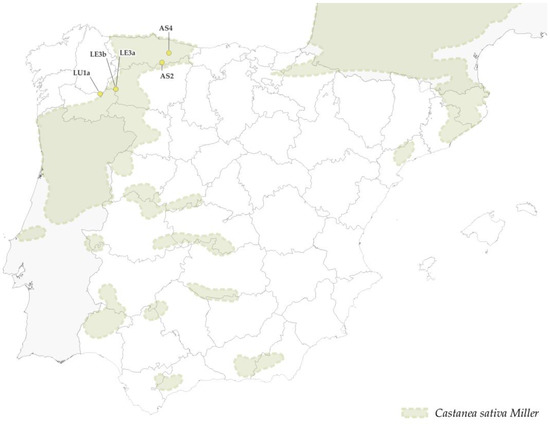
Figure 7.
Distribution map of the species Castanea sativa Miller and locations of the case studies identified as belonging to this species. Map drawn up by the authors using information obtained from the database Chorological Data for the Main European Woody Species [42].
3.3. Populus Genus
Samples BU1, CA2, RI1, PA1, and SE1 were microscopically identified as belonging to the Populus group of broadleaf, where the different species cannot be distinguished, based on their microscopic characteristics. The main identification features observed were the presence of diffuse- to semi-ring-porous, uniseriate, and homogeneous rays between 10 and 15 cells long, vessels with simple perforations and no helical thickening, and cross-fields with simple and large pits (Figure 8) [41].

Figure 8.
Characteristic sections identified as belonging to the Populus genus: (a) Cross-section of sample BU1; (b) Tangential section of sample CA2; (c) Radial section of sample PA1.
Although it is not possible to identify the specific species, the size of the vessels [46] and broader geographical presence in the northwest of Spain of the species Populus alba I., Populus nigra L., and Populus tremula I. [47] presumably make it possible to rule out the species Populus euphratica Olivier (Figure 9) [42]. In any case, this species group is characterised for its large, rapidly growing trunks, with a generally light density, and is softwood with a medium strength [44]. However, poplar wood displays very limited durability due to fungal rot, termites, and coleopterans, so according to some authors, the useful lifespan of wood exposed to outdoor elements is limited to only 5 years unless a protective treatment is applied [44]. In terms of workability, this is considered an issue when executing traditional joints or nail joints.
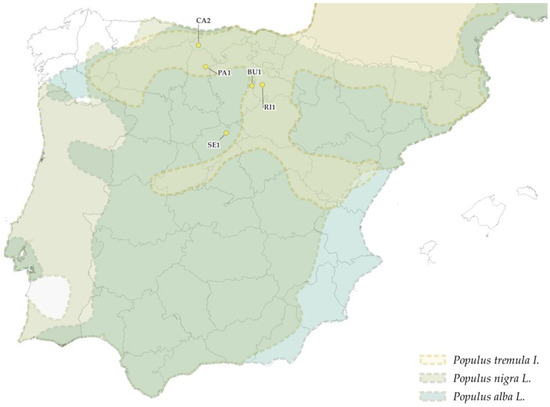
Figure 9.
Distribution map of the species Populus tremula I., Populus nigra L., and Populus alba L. and location of the case studies identified as belonging to this group of species. Map drawn up by the authors using information obtained from the database Chorological Data for the Main European Woody Species [42].
All these samples were extracted from structural elements in the framework of the half-timber wall. They were extracted from horizontal beams in the case of samples BU1, CA2, and RI1, located in Fresneda de la Sierra Tirón (Burgos), Tudes (Cantabria), and Berceo (La Rioja), respectively, and from vertical uprights from samples PA1 and SE1, located in San Pedro de Ojeda (Palencia) and Valle de Tabladillo (Segovia), respectively.
3.4. Quercus Genus
Samples PA2, LE2, and RI3 have been identified as belonging to the Quercus genus, due to the presence of porous rings with vessels in dendritic patterns, apotracheal parenchyma in bands, and multiseriate rays visible to the naked eye along with unicellular rays (Figure 10) [41].

Figure 10.
Characteristic sections identified as belonging to the Quercus genus: (a) Transversal section of sample PA2; (b) Longitudinal section of sample LE2; (c) Radial section of sample RI3.
Among the species belonging to the Quercus genus, the subgenera Quercus Erythrobalanus and Quercus Cerris were ruled out given the absence of a slightly gradual transition of the size of the vessels and the absence of a relatively thick cellular wall of the vessels, while the subgenus Quercus Scleropphyllodry was ruled out due to the absence of rings with slightly diffuse porosity. Therefore, these have been identified as belonging to the Quercus subgenus, and its distribution all over Spain may have suggested the existence of species such as Quercus robur L., Quercus petraea Liebl., Quecus pyrenaica Willd., or Quercus faginea Lam. However, no specific species could be identified, as they are all found relatively close to the samples obtained (Figure 11). These species generally offer large timber with heavy density, medium structural resistance, strong hygroscopicity, and particularly long durability due to the presence of tannins [44].
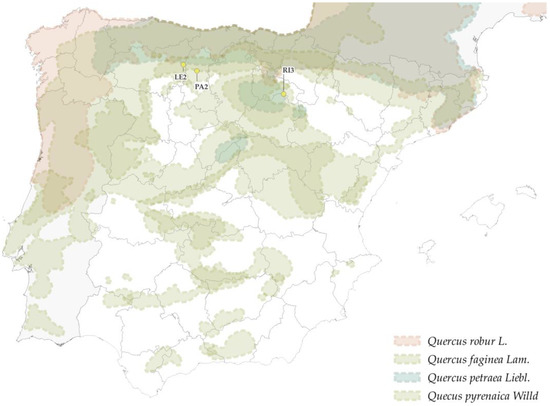
Figure 11.
Distribution map of the species Quercus robus L., Quercus faginea Lam., Quercus petraea Liebl., and Quercus pirenaica Willd and location of the case studies identified as belonging to this group of species. Map drawn up by the authors using the information obtained from the database Chorological Data for the Main European Woody Species [42].
As with the samples identified as belonging to the Populus group, all the samples identified as belonging to the Quercus group were found in structural elements. Sample PA2 was extracted from the beam from a half-timbered wall located in Renedo de Valdavia (Palencia), while samples LE2 and RI3 were extracted from uprights located Calaveras de Arriba (León) and El Villar (La Rioja), respectively.
3.5. Salix Genus
Only sample LU1b has been identified as belonging to the Salix genus, specifically in an encestada screen located in Peites (Lugo). The main features observed were the presence diffuse- to semi-ring-porous wood, uniseriate and heterogeneous rays with a mean height of between 10 and 15 cells made up of several rows of square cells combined with marginal rows of slightly vertical cells, simple perforations, and wide and simple pitting of the cross-fields (Figure 12) [41].

Figure 12.
Characteristic sections identified as belonging to the Salix genus: (a) Transversal section of sample LU1b; (b) Longitudinal section of sample LU1b; (c) Radial section of sample LU1b.
On a microscopic level, it is not possible to distinguish between many of the species belonging to the Salix genus, although in the Iberian Peninsula, only Salix alba L., Salix caprea L., and Salix eleagnos Scop have been documented (Figure 13) [42]. In general, this type of species is associated with soft lightweight wood with limited durability [44]. The young branches are very flexible and have been used for the execution of basketry elements and lightweight furniture [48].
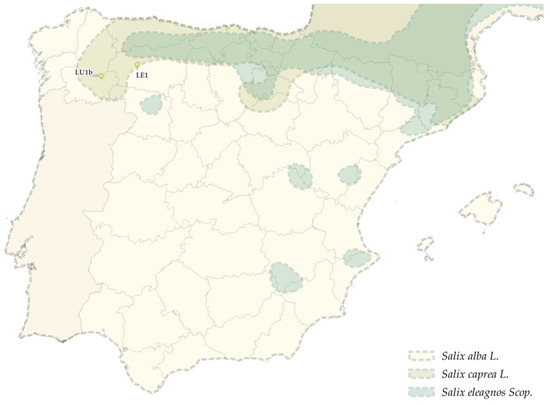
Figure 13.
Distribution map of the species Salix alba L., Salix caprea L., and Salis eleagnos Scop. and location of the case studies identified as belonging to this species group. Map drawn up by the authors using information obtained from the database Chorological Data for the Main European Woody Species [42].
3.6. Fagus Genus
Sample RI2, extracted from the beam of a half-timber wall located in Poyales (La Rioja), was the only one identified as belonging to the Fagus species group. The features observed were mostly the presence of diffuse-porous to semi-ring-porous, grouped vessels in the earlywood and isolated vessels in the latewood, and the existence of homocellular rays both in multicellular groups visible to the naked eye and in unicellular ones (Figure 14) [41]. Although initially it is not possible to establish an anatomical distinction for Fagus sylvatica I. and Fagus orientalis Lipsky, the latter can be ruled out as it is not found in Spain (Figure 15) [42]. The species Fagus sylvatica I., or common beech, has a long trunk 30 to 35 m high and up to 1 m in diameter, with medium-density and medium-resistance timber [44]. It generally displays low durability due to fungi, termites, and fine woodworm, although in the specific case of fine woodworm, it increases in the duramen.

Figure 14.
Characteristic sections of sample RI2 identified as belonging to the Fagus genus: (a) Cross-section; (b) Tangential section; (c) Radial section.
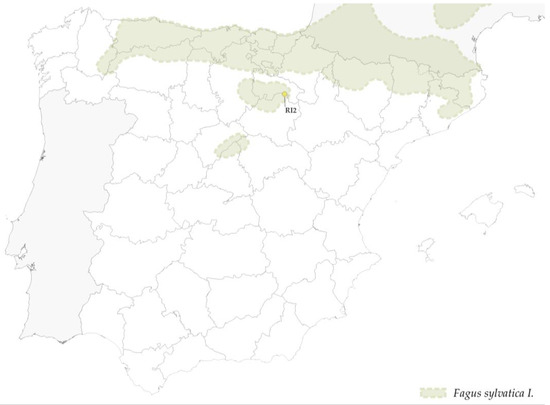
Figure 15.
Distribution map of the Fagus sylvatica I. species and location of the case studies identified as belonging to this species. Map drawn up by the authors using information obtained from the database Chorological Data for the Main European Woody Species [42].
3.7. Alnus Genus
The only sample identified as belonging to the Alnus genus is LE1, taken from the lath of a lath-and-daub enclosure of a half-timber wall in Almagarinos (León). These have been identified through the features, mostly the presence of diffuse to semi-ring-porous with vessels in radial groups, the presence of uniseriate homogeneous rays up to 25 cells long, as well as scalariform perforations of over 20 bars (Figure 16) [41]. These last two characteristics are the main distinguishing factors between this genus and the samples belonging to the genus Corylus, where the rays are heterogeneous and the bars of the scalariform perforations are limited to 5 or 10. At the microscopic level, it is not possible to distinguish between the species Alnus cordata Loisel, Alnus orientalis Decaisne, Alnus incana L., and Alnus glutinosa L., although, given that the latter is the only species documented in Spain, the others can be ruled out (Figure 17). The species Alnus glutinosa L., alder, is characteristically found in Spain and has a slightly irregular trunk that tends to be around 30 cm thick and 10–12 m high [44]. This hardwood timber has a relatively low structural resistance, and is low density, so it is relatively easy to execute unions using nails, screws, and other metal elements. However, in general, its durability is very low and it is very susceptible to rot, although it noticeably improves when permanently submerged.

Figure 16.
Characteristic sections of sample LE1 identified as belonging to the Alnus genus: (a) Cross-section; (b) Tangential section; (c) Radial section.
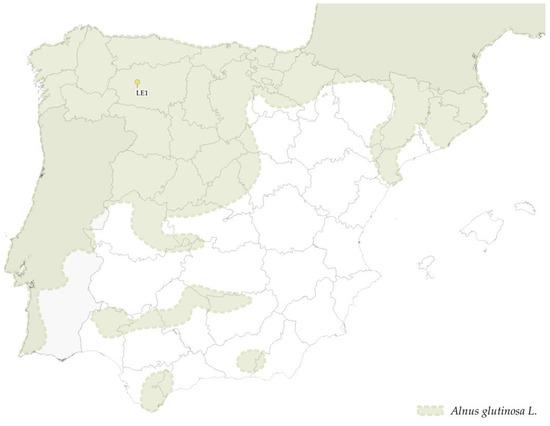
Figure 17.
Distribution map of the species Alnus glutinosa L. and location of the cases identified as belonging to this species. Map drawn up by the authors using information obtained from the database Chorological Data for the Main European Woody Species [42].
3.8. Pinus sylvestris L.
Samples BU2 and TE1 have been identified as belonging to the Pinus sylvestris L. and Pinus mugo Turra species groups, which cannot be clearly distinguished at an anatomical level [41]. The features observed were the presence of resin ducts with thin epithelial cell walls and the presence of resin ducts within rays, heterocellular rays with a mean height of 8 to 15 cells, large fenestriform pitting of cross-fields, and strongly serrated walls on the radial tracheids (Figure 18) [41]. However, considering the absence of Pinus mugo Turra in the Iberian Peninsula, it could be assumed that these samples probably belong to the species Pinus sylvestris L. (Figure 19) [42], commonly known as Scots pine. This wood is characterised by a straight trunk with few branches, medium density, medium resistance, and hygroscopicity and a limited durability to rot, termites, and woodworms [49].

Figure 18.
Characteristic sections identified as belonging to the species Pinus sylvestris L: (a) Cross-section of sample BU2; (b) Tangential section of sample BU2; (c) Radial section of sample TE1.
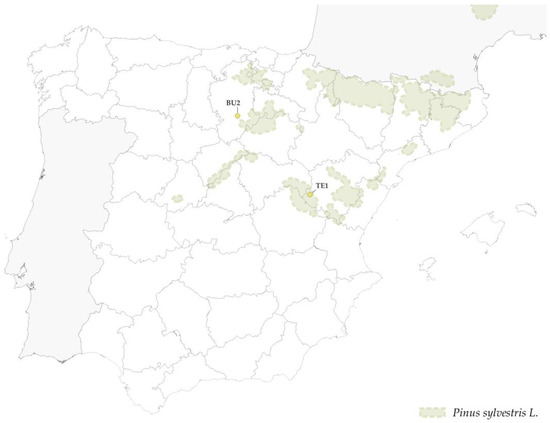
Figure 19.
Distribution map for the species Pinys sylvestris L. and location of the case studies identified as belonging to this species. Map drawn up by the authors using information obtained from the database Chorological Data for the Main European Woody Species [42].
3.9. Pinus pinaster Aiton
Samples OU1 and OU2 have been identified as belonging to the species Pinus pinaster Aiton based on the presence of relatively large resin ducts with thin-wall epithelial cells, heterocellular rays with a mean height of 10 cells, small pinoid to taxodioid pitting in the cross-fields, and the clearly serrated walls of radial tracheids (Figure 20) [41]. The timber of this species, known as maritime pine, displays a characteristically light density, a hygroscopicity that tends to be low, and medium structural resistance [49]. While the duramen displays considerable resistance to rot fungi, termites, and xylophagous insects, the sapwood is highly susceptible to this type of degradation. In both cases, these samples (OU1 in Biobra (Ourense) and OU2 in Manzaneda (Ourense)) are vertical structural elements from the half-timber walls with lath-and-daub enclosures (Figure 21).

Figure 20.
Characteristic sections identified as belonging to the species Pinus pinaster Aiton: (a) Cross-section of sample OU1; (b) Tangential section of sample OU1; (c) Radial section of sample OU2.
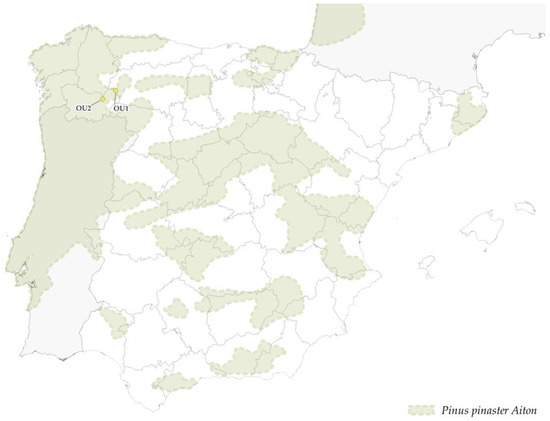
Figure 21.
Distribution map of the species Pinys pinaster Aiton and location of the case studies identified as belonging to this species. Map drawn up by the authors using information obtained from the database Chorological Data for the Main European Woody Species [42].
3.10. Juniperus Genus
The only example identified as belonging to the Juniperus genus is sample SO1, extracted from the upright of a building in Rejas de San Esteban (Soria). The microscopic characteristics relevant to its identification were the absence of resin ducts, axial and radial parenchyma cells with brown substances, homocellular rays with a mean height of between 2 and 5 cells, cupressoid pits, and nodular walls between ray cells (Figure 22) [41]. On a microscopic level, it is not possible to distinguish between the species that make up this genus. However, from analysis of the species found in Spain [42] and their characteristics, it can be assumed that this is Juniperus thurifera L., as the other species found in the Spanish climate are generally shrublike and not always suited to construction (Figure 23). Equally, the available documentation suggests that there was a traditionally widespread use for construction in the region of Juniperus thurifera L. wood [50,51], although Spanish juniper is currently a protected species. It is characterised by a medium density and intermediate hardness, but above all, a very high durability [49].

Figure 22.
Sections characteristic of sample SO1, identified as belonging to the Juniperus genus: (a) Cross-section; (b) Tangential section; (c) Radial section.
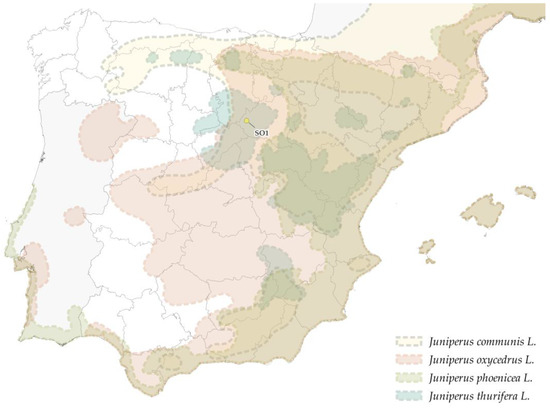
Figure 23.
Distribution map for the species Juniperus communis L., Juniperus oxycedrus L., Juniperus phoenicea L., and Juniperus thurifera L. and locations of case studies identified as belonging to this species group. Map drawn up by the authors using information obtained from the database Chorological Data for the Main European Woody Species [42].
4. Cross-Analysis of Constructive Characteristics and Timber Species
Traditional architecture uses the resources available in a given location to provide a response to constructive needs, while also developing constructive systems and techniques that partly depend on the materials available. As illustrated previously, all the samples analysed are geographically relatively close to the timber species identified, as are the materials used for filling or enclosure of the spaces of the framework [36]. Below is a cross-analysis of the constructive function of the elements from which the samples studied were obtained and the characteristics of the species or species group identified, depending on whether they are used for structural elements such as uprights or beams or whether they are laths or rods used in the construction of the enclosure of the framework (Figure 24).
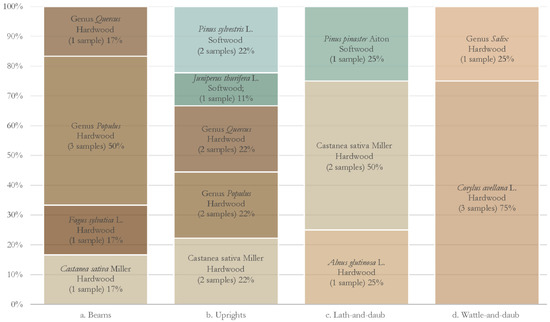
Figure 24.
Distribution of the different species identified based on their presence in structural elements such as beams and uprights or in enclosure elements such as laths or flexible rods.
By its very nature, a half-timber wall requires the existence of a structural framework in charge of transmitting its own weight as well as the loads from other constructive elements it supports. Therefore, despite the confirmation of a degree of structural collaboration between the timber and the materials used as a filling [52], the timber still requires sufficient structural capacity to fulfil this function. Although the use of a specific wood species depends mainly on local availability or the possibility of importing these by river routes, in terms of construction, it is necessary to have species with good structural behaviour for the development and execution of this type of structure (Figure 25). It is also necessary for the species to develop a trunk large enough to obtain square elements of 10–20 cm. Although height could also be a conditioning factor for the selection of a given species, the possibility of splicing to allow the creation of longer elements mean that this was not as limiting a factor.
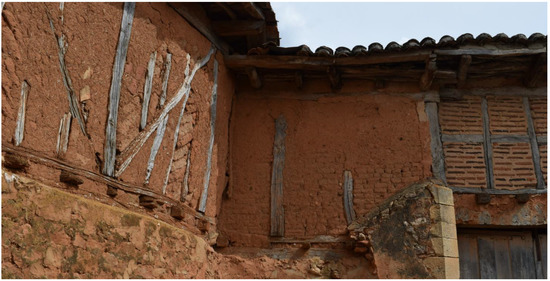
Figure 25.
Half-timber wall with heavy adobe filling, where the wood used for the construction of the framework must meet minimum mechanical resistance requirements. Building located in Pedro de Ojeda (Palencia), with the sample PA1 analysed and identified as belonging to the Populus genus.
The timber framework is made up of main vertical elements known as uprights, which are connected at the ends to other main horizontal elements, known as beams, sills, or wall plates, depending on their position. While the vertical elements are subject to a greater extent to compression parallel to the fibre of the timber, the horizontal elements are subjected to stress when there is no filling in the lower space and to bending strength perpendicular to the fibre when there is filling both in the upper and lower sections. Among the horizontal elements, broadleaf species or species groups with a high resistance to bending strength such as Fagus sylvatica L. and the genus Quercus have been identified, as well as a species with an intermediate resistance to bending strength such as Castanea sativa Miller and the Populus genus. The use of wood from Pinus pinaster Aiton, with a relatively high resistance to bending strength among the conifer species found in Spain, has also been identified. In the vertical elements species or species groups with relatively high resistance to axial compression, either broadleaves such as Castanea sativa miller, Quercus, and Populus, or conifers such as Pinus sylvestris L. and Juniperus thurifera L. have been documented. In all cases, the species identified are found in forests near the location of the documented use and they display dimensions, characteristics, and mechanical behaviour that make them suitable in varying degrees for the construction of half-timber walls.
The constructive solutions and materials used to fill or enclose the spaces outlined by the framework also depend on locally available resources. This framework can be filled using heavy materials covering different monolithic solutions, such as piled earth, tapialete, earth and lime concrete, and masonry formwork, as well as solutions based on the stacking of adobe constructions, brick or ashlar [2]. On other occasions, these spaces are closed using flexible wooden elements such as wattles, reeds, or wicker and rigid wooden elements such as laths or bars, combined in most cases with earth, plant fibres, and other elements in order to increase the resistance, durability, and insulation of the enclosure. In these cases, the rigidity or flexibility of the species available in the region is a determining factor for the development of a given solution.
In the case of rigid screens, there are documented examples of timber with relatively high structural resistance such as Pinus pinaster Aiton and Castanea sativa Miller, as well as examples of Alnus glutinosa L. with its characteristic low structural resistance. In any case, its use for laths of the lath-and-daub does not require good mechanical behaviour in principle, as it does not act simply as an enclosure and, therefore, is presumably not a factor to consider when selecting a given species. These examples of lath-and-daub are executed by nailing or fitting laths to form single or double panels that could be rendered or filled in with other materials, so it is preferable to use branches or elements rigid enough to withstand this filling (Figure 26a). Examples of the Salix genus and the Corylus avellana L. species have been documented in the execution of wattle-and-daub screens. The young branches of these species are extremely flexible so that they can be braided around an auxiliary timber substructure, a solution that would be impossible with more rigid branches (Figure 26b).
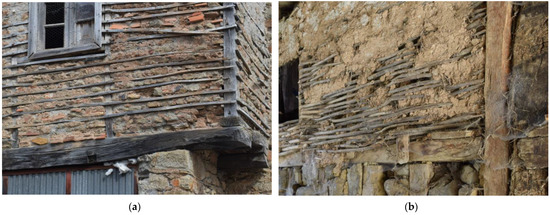
Figure 26.
Half-timber walls with lightweight enclosures executed using wooden elements: (a) lath-and-daub enclosure with laths identified as Alnus glutinosa L. in Almagarinos (León); (b) Wattle-and-daub enclosure with flexible rods identified as Corylus avellana L. in Caloca (Cantabria).
In terms of the durability of the species documented, it should be highlighted that the species documented in structural elements generally display greater durability than the species documented in screens. As the replacement or repair of a structural element in this type of arrangement would be relatively complex, the use of more durable species found in the area is preferable. The sole documented example with very limited durability in structural elements is the Populus species group, which requires specific treatment for protection from the atmospheric elements. Coatings are conceived as a layer of protection against these external degradation agents [53]. Almost half of the sample of half-timber walls studied in Spain have some kind of mortar rendering or coating based on the use of pieces such as boards, slate slabs, or roof tiles [36]. The mud mortar found in half of the cases where the use of poplar timber has been microscopically identified was highly degraded. In the rest, it is difficult to determine whether there was originally a protective layer lost over time. However, the use of this timber is understandable given the widespread presence and availability of this type of tree on the riverbanks and the fact that all the locations with documented use are located on the banks of a river. Therefore, although this material is not entirely optimal for the construction of half-timber walls, it is easily obtained locally.
The species documented in rigid and flexible screens, with the exception of the species Castanea sativa Miller, have low or very low durability. In general, the constructive layout of these elements facilitates their easy replacement, especially when these are nailed on the exterior as in the case of the lath-and-daub. The replacement of some wattle-and-daub branches in flexible panels could be relatively more complex, even requiring the full replacement of the panel. However, in these cases, it is common to apply a mud mortar rendering to protect the branches from degradation phenomena caused by the elements and to provide a degree of solidity when degradation is observed in these branches.
5. Conclusions
The analysis carried out suggests that the choice of species depends on their local availability, influencing the development of certain constructive solutions depending on their characteristics, resistance, and durability. It is worth noting the use of relatively resistant and long-lasting species for the execution of the structural element of the half-timber wall, with examples of conifers such as maritime pine, Scots pine, and Spanish juniper and broadleaf species such as the chestnut tree, oak, or beech. The use of less optimal species, such as poplar, was also documented, always in relation to local availability. Chestnut was documented both in structural elements, as the wood from its trunk is strong and durable enough, and in lath-and-daub, where its branches are used. While the species documented in structural elements are relatively durable, this does not tend to be the case with the species documented in lath-and-daub and wattle-and-daub although their constructive layout allows them to be replaced with greater ease. In the specific case of wattle-and-daub, the flexibility of the branches is essential so that they can be interwoven, and there are documented examples of the use of hazel and willow.
All of the above suggest that among the species available in a given location, builders chose those that offered an optimal response to the constructive needs of individual elements, conferring a considerable element of sustainability and efficiency to these techniques and to traditional architecture in general. This can also be seen as a reflection of the intuitive technical knowledge of builders—regardless of whether they were joiners or merely inhabitants—regarding the materials available [38].
Author Contributions
Conceptualization, A.H.-E. and F.V.L.-M.; methodology A.H.-E. and C.M.; software, A.H.-E.; validation, A.H.-E.; formal analysis, A.H.-E.; investigation, A.H.-E.; resources, A.H.-E., F.V.L.-M. and C.M.; data curation, A.H.-E.; writing—original draft preparation, A.H.-E.; writing—review and editing, A.H.-E., F.V.L.-M. and C.M.; visualization, A.H.-E.; supervision, F.V.L.-M. and C.M.; project administration, C.M. and F.V.L.-M.; funding acquisition, C.M. and F.V.L.-M. All authors have read and agreed to the published version of the manuscript.
Funding
This work is part of the research project “Risk-Terra: La arquitectura de tierra en la Península Ibérica: Estudio de los riesgos naturales, sociales y antrópicos y estrategias de intervención e incremento de la resiliencia” (Ref. RTI2018-095302-B-I00; main researchers: Camilla Mileto y Fernando Vegas), funded by the Spanish Ministry of Science, Innovation and University. This research has been developed within a doctoral thesis funded by the Spanish Ministry of Science, Innovation and University (Ref. FPU18/01596).
Data Availability Statement
Not applicable.
Acknowledgments
The analysis and identification of the samples were made possible with the assistance of the staff and the availability of the installations and tools of the research centre Istituto per la bioeconomía del Consiglio Nazional delle Ricerche, particularly its branch in Sesto Fiorentino, Firenze (Italy).
Conflicts of Interest
The authors declare no conflict of interest. The funders had no role in the design of the study; in the collection, analyses, or interpretation of data; in the writing of the manuscript, or in the decision to publish the results.
References
- Oliver, P. Encyclopedia of Vernacular Architecture of the World; Cambridge University Press: Cambridge, UK, 1997. [Google Scholar]
- Hueto Escobar, A.; Mileto, C.; Vegas, F. The Constructive Variety of Half-Timbered Walls with Earth Infill: Proposal for the Geographical Classification of the Spanish Territory. In Proceedings of the Earthen and Wood Vernacular Heritage and Climate Change, Lund, Sweden, 28–30 August 2021; Dabaieh, M., Ed.; Lunds Universitet: Lund, Sweden, 2021; pp. 134–139. [Google Scholar]
- De Hoz Onrubia, J.; Maldonado Ramos, L.; Vela Cossío, F. Diccionario de Construcción Tradicional Tierra; Editorial Nerea: San Sebastián, Spain, 2003. [Google Scholar]
- Maldonado Ramos, L.; Rivera Gámez, D. El Entramado de Madera Como Arquetipo Constructivo: De La Arquitectura Tradicional a Los Sistemas Modernos. In Proceedings of the Actas del Cuarto Congreso Nacional de Historia de la Construcción, Cádiz, Spain, 27–29 January 2005; Huerta, S., Ed.; I. Juan de Herrera, SEdHC, Arquitectos de Cádiz, COAAT Cádiz: Madrid, Spain, 2005; pp. 687–697. [Google Scholar]
- Nuere Matauco, E. Construcción Entramada. In La Carpintería de Armar Española; Munillalería: Madrid, Spain, 2000; pp. 26–43. [Google Scholar]
- Arias y Scala, F. Carpintería Antigua y Moderna, 3rd ed.; F. Nacente: Barcelona, Spain, 1893. [Google Scholar]
- Bails, B. Elementos de Matemática. Tomo IX. Parte I. Arquitectura Civil, 2nd ed.; Imprenta de la Viuda de D. Joaquín Ibarra; Fondo Antiguo de la Biblioteca de la Universidad de Sevilla: Madrid, Spain, 1796. [Google Scholar]
- Ger y Lobez, F. Tratado de Construcción Civil; La Minerva Extremeña: Badajoz, Spain, 1898. [Google Scholar]
- Marcos y Bausa, R. Manual Del Albañil, 3rd ed.; Tipografía de Gregorio Estrada: Madrid, Spain, 1879. [Google Scholar]
- de Villanueva, J. Arte de Albañilería; Oficina de Don Francisco Martínez Dávila: Madrid, Spain, 1827. [Google Scholar]
- Hueto Escobar, A.; Vegas López-Manzanares, F.; Mileto, C. El Proceso Constructivo de Los Muros Entramados de Madera Según Los Tratados Españoles Del Siglo XIX. Análisis de La Implementación de Los Criterios y Recomendaciones En Los Ejemplos Conservados En España. In Proceedings of the Actas del Duodécimo Congreso Nacional y Cuarto Congreso Internacional Hispanomericano de Historia de la Construcción, Mieres, Spain, 4–8 October 2022; Plasencia-Lozano, P., Rodríguez García, A., Hernando de la Cuerda, R., Huerta, S., Eds.; I. Juan de Herrera, Escuela Técnica Superior de Arquitectura de Madrid: Madrid, Spain, 2022; pp. 545–554. [Google Scholar]
- Flores, C. Arquitectura Popular Española; Aguilar: Madrid, Spain, 1973. [Google Scholar]
- Feduchi, L. Itinerarios de Arquitectura Popular Española; Editorial Blume, Editorial Labor: Barcelona, Spain, 1974. [Google Scholar]
- García Mercadal, F. La Casa Popular En España, 1st ed.; Espasa-Calpe S.A.: Madrid, Barcelona, 1930. [Google Scholar]
- De Yrizar, J. Arquitectura Popular Vasca. In Proceedings of the V Congreso de Estudios Vascos, Vergara, Spain, Ed., 1–8 September 1930; Eusko Ikaskuntza - Sociedad de Estudios Vascos, Ed.; Nueva Editorial: San Sebastián, Spain, 1934; pp. 80–91. [Google Scholar]
- Caro Baroja, J. La Casa En Navarra; Caja de Ahorros de Navarra: Burlada, Spain, 1982. [Google Scholar]
- Houben, H.; Guillaud, H. Traité de Construction En Terre; CRAterre-EAG, Parentheses: Marseille, France, 1989. [Google Scholar]
- Guillaud, H.; Graz, C.; Nousissier, G.; Castro, A.; Simeone, G.G.; Correia, M.; Mecca, S.; Mileto, C.; Vegas, F. (Eds.) Terra Incognita: Discovering European Earthen Architecture; Argumentum, Culture Lab Éditions: Lisboa, Portugal; Bruselas, Belgium, 2008. [Google Scholar]
- Correia, M.; Dispaquale, L.; Mecca, S. (Eds.) Terra Europae: Earthen Architecture in the European Union; ETS: Pisa, Italy; Tervuren, Belgium, 2011. [Google Scholar]
- Mileto, C.; Vegas, F. La Restauración de La Tapia En La Península Ibérica: Criterios, Técnicas, Resultados y Perspectivas; Argumentum, TC Cuadernos: Valencia, Spain, 2014; ISBN 9788578110796. [Google Scholar]
- Nuere Matauco, E. La Carpintería de Armar Española; Munillalería: Madrid, Spain, 2000. [Google Scholar]
- Nuere, E.; Cabeza, P. Rehabilitación: Madera En La Edificación; AITIM Asociación de Investigación Técnica de las Industrias de la Madera y Corcho AITIM, Nueva Editorial: San Sebastián, Spain, 2021; ISBN 9788487381546. [Google Scholar]
- Arriaga, F.; Peraza, F.; Esteban, M.; Bobadilla, I.; García, F. Intervencion En Estructuras de Madera; AITIM: Madrid, Spain, 2002. [Google Scholar]
- Pasquet, L. La Restauration Des Constructions En Pans de Bois: Remplissage Terre; Agence Nationale Pour l’Amélioration de l’Habitat: Pairs, France, 1986. [Google Scholar]
- Valentin, J.-L. Le Colombage, Mode D’emploi; Eyrolles: Pairs, France, 2007. [Google Scholar]
- Fritzinger, M. Les Colombages—l’hybride de Demain; Ecole Polytechnique Fédérale de Lausanne: Écublens, Switzerland, 2018. [Google Scholar]
- Reimann, G.J. Fachwerkbauten in Der Deutschen Demokratischen Republik; VEB Brockhaus: Leipzig, Germany, 1964. [Google Scholar]
- Beckmann, E.-M.; Sutthoff, L.J. Gebäude Aus Fachwerk Konstruktion—Schäden—Instandsetzung; LVR-Amt für Denkmalpflege im Rheinland: Pulheim, Germany, 2018. [Google Scholar]
- Fiedler, W. Das Fachwerk in Deutschland, Frankreich Und England; Verlag Von Ernst Wasmuth: Tübingen, Germany, 1903; ISBN 9783826230035. [Google Scholar]
- Dipasquale, L.; Omar Sidik, D.; Mecca, S. Local Seismic Culture and Earthquake-Resistant Devices: Case Study of Casa Baraccata. In Vernacular Architecture: Towards a Sustainable Future; Mileto, C., Vegas, F., García-Soriano, L., Cristini, V., Eds.; Taylor & Francis Group: Milton Park, UK, 2014; pp. 255–260. [Google Scholar]
- Bianco, A. La Casa Baraccata. Guida Al Progetto e Al Cantiere Di Restauro; Ginevra Bentivoglio Editoria: Rome, Italy, 2010. [Google Scholar]
- Stellacci, S.; Rato, V.; Poletti, E. Structural Permanence in Pre- and Post-Earthquake Lisbon: Half-Timbered Walls in Overhanging Dwellings and in Pombalino Buildings. Int. J. Archit. Herit. 2017, 11, 363–381. [Google Scholar] [CrossRef]
- Stellacci, S.; Rato, V.; Poletti, E.; Vasconcelos, G.; Borsoi, G. Multi-Criteria Analysis of Rehabilitation Techniques for Traditional Timber Frame Walls in Pombalino Buildings (Lisbon). J. Build. Eng. 2018, 16, 184–198. [Google Scholar] [CrossRef]
- Gülkan, P.; Langenbach, R. Traditional Timber-Laced Masonry Construction in Turkey Known as Himiş. In Masonry Construction in Active Seismic Regions; Rupakhety, R., Gautam, D., Eds.; Woodhead Publishing; Elsevier: Amsterdam, The Netherlands, 2021; pp. 61–97. [Google Scholar]
- Langenbach, R. Timber 2.0: Resilience and Vulnerability of Wood Construction in Earthquakes and Fires. In Proceedings of the SHATIS’17: 4th International Conference on Structural Health Assessment of Timber Structures, Istanbul, Turkey, 20–22 September 2017; Arun, G., Ed.; Hasan Kalyoncu University: Gaziantep, Turkey, 2017. [Google Scholar]
- Hueto-Escobar, A.; Mileto, C.; Vegas López-Manzanares, F.; Macchioni, N. Traditional Constructive Techniques and Their Relation to Geographical Conditioning Factors. The Case of Half-Timbered Walls in Spain Conditioning Factors. The Case of Half-Timbered Walls in Spain. Int. J. Archit. Herit. 2022, 1–23. [Google Scholar] [CrossRef]
- Hueto Escobar, A.; Diodato, M.; Vegas, F.; Manzano Fernández, S. Approximation to the Use of Half-Timbered Walls with Earth Infill in Spanish Traditional Architecture. Int. Arch. Photogramm. Remote Sens. Spat. Inf. Sci.-ISPRS Arch. 2020, 54, 1033–1040. [Google Scholar] [CrossRef]
- Diodato, M.; De Gregorio, S. Identificación Microscópica, Una Herramienta Fundamental En La Investigación de Estructuras Históricas de Madera: Casos Prácticos. Arché 2015, 10, 377–386. [Google Scholar]
- Hueto Escobar, A.; Mileto, C.; Vegas López-Manzanares, F.; Diodato, M. Preliminary Analysis of Material Degradation Processes in Half-timbered Walls with Earth Infill in Spain. Sustainability 2021, 13, 772. [Google Scholar] [CrossRef]
- Hueto Escobar, A.; Vegas López-Manzanares, F.; Mileto, C.; Lidón de Miguel, M. State of Conservation of Half-Timbered Walls in Burgos (Spain): Quantitative Analysis of Material and Structural Degradation. In Proceedings of the Vernacular Heritage: Culture, People and Sustainability, Valencia, Spain, 15–17 September 2022; Mileto, C., Vegas, F., Cristini, V., García-Soriano, L., Eds.; Editorial Universitat Politècnica de València: Valencia, Spain, 2022; pp. 377–384. [Google Scholar]
- Schweingruber, F.H. Anatomy of European Woods: An Atlas for the Identification of European Trees, Shrubs and Dwarf Shrubs; WSLFNP: Bern, Swiss, 1990; ISBN 3258042586. [Google Scholar]
- Caudullo, G.; Welk, E.; San-Miguel-Ayanz, J. Chorological Data for the Main European Woody Species. Mendeley Data 2022, V15. [Google Scholar] [CrossRef]
- Pardo de Santayana, M.; Morales, R.; Tardío, J.; Molina, M. (Eds.) Inventario Español de Los Conocimientos Tradicionales Relativos a La Biodiversidad. Fase II.; Ministerio de Agricultura y Pesca, Alimentación y Medio Ambiente: Madrid, Spain, 2018; Volume 1, ISBN 9788449114724. [Google Scholar]
- Vignote Peña, S. Principales Maderas de Frondosas de España Características, Tecnología Y Aplicaciones; E.T.S.I Montes, Universidad Politécnica de Madrid: Madrid, Spain, 2015. [Google Scholar]
- Schweingruber, F.H. Microscopic Wood Anatomy; Kommissionsverlag Zürcher: Zug, Swiss, 1978. [Google Scholar]
- Hoadley, R.B. Identifying Wood: Accurate Results with Simple Tools; The Taunton Press: Newtown, CT, USA, 1990. [Google Scholar]
- García Esteban, L.; Guindeo Casasús, A.; Peraza Oramas, C.; De Palacios De Palacios, P. La Madera y Su Anatomía. Anomalías y Defectos, Estructura Microscópica de Coníferas y Frondosas, Identificación de Maderas, Descripción de Especies y Pared Celular; Fundación Conde del Valle de Salazar, Edificiones Mundi-Prensa, AiTiM: Madrid, Spain, 2003; ISBN 978-84-8476-153-2. [Google Scholar]
- Kroustallis, S.K. Diccionario de Materias y Técnicas. Tesauro Para La Descripción y Catalogación de Bienes Culturales; Ministerio de Cultura: Madrid, Spain, 2008; Volume 1, ISBN 9788481813821. [Google Scholar]
- Vignote Peña, S. Principales Maderas de Coníferas En España: Características, Tecnología y Aplicaciones; Universidad Politécnica de Madrid: Madrid, Spain, 2014; pp. 108–115. [Google Scholar]
- Checa, J.R.R.; Cristini, V. Juniper Timber: Potentiality of a Vernacular Raw Material. Adv. Mater. Res. 2011, 250–253, 1143–1146. [Google Scholar] [CrossRef]
- Gil Crespo, I.J. Geographical Cataloguing of Earthen Architecture in Soria, Spain. In Vernacular Heritage and Earthen Architecture: Contributions for Sustainable Development; Correia, M., Carlos, G., Rocha, S., Eds.; Taylor & Francis Group: London, UK, 2013; pp. 123–128. [Google Scholar]
- Santa Cruz-Astorqui, J.; Del Río, M. Modelo de Comportamiento Estructural de Muros Entramados de Madera En El Siglo XIX En España. Informes de la Construcción 2014, 66, e048. [Google Scholar] [CrossRef]
- Maldonado, L.; Vela Cossío, F. Arquitectura Popular En El Valle Del Tiétar. Narria Estudios de artes y costumbres Pop. 1996, 75, 1–7. [Google Scholar]
Disclaimer/Publisher’s Note: The statements, opinions and data contained in all publications are solely those of the individual author(s) and contributor(s) and not of MDPI and/or the editor(s). MDPI and/or the editor(s) disclaim responsibility for any injury to people or property resulting from any ideas, methods, instructions or products referred to in the content. |
© 2023 by the authors. Licensee MDPI, Basel, Switzerland. This article is an open access article distributed under the terms and conditions of the Creative Commons Attribution (CC BY) license (https://creativecommons.org/licenses/by/4.0/).